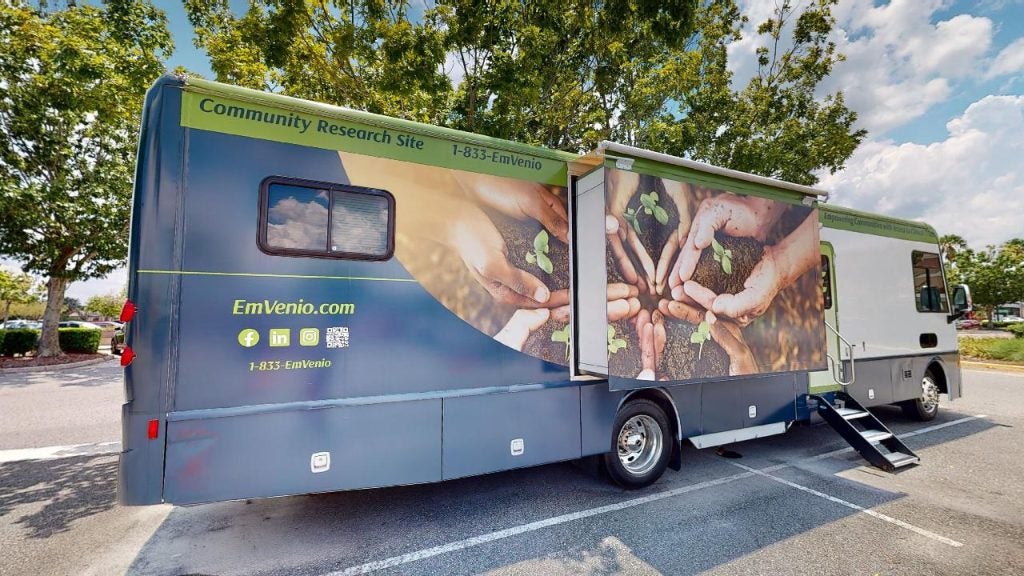
According to the latest data from CISCRP, the physical location/proximity of a research study center is one of the most important factors in a patient’s decision of whether to participate in a clinical trial.[1] However, recent research from GlobalData has highlighted the problems of the traditional model when it comes to reach. The interactive map below shows the number of ongoing single-country US trials being conducted per each 3-digit zip code region.
As the map represents, there are significant pockets of the US where no trial options exist, particularly in the Midwest’s East region (e.g. the Dakotas) and the South’s West region (e.g. Texas, Oklahoma). In addition, certain highly populous states offer a disproportionately limited number of clinical trial access opportunities. Texas, for example, is home to 9.04% of the US population as per 2023 census data, yet just 3.56% of today’s trials have a site there. A similar pattern is seen across all but one of the southern US states, with the exception being Delaware. Moreover, taking the southern states as a region and comparing it to the three other regions defined by the US Census (Midwest, Northeast, and West), the South represents the highest portion of the national population by far (37.45%) but has the second-lowest percentage of ongoing trials.
The opposite effect is observed in the Midwest, with all but one state (Indiana) having a higher percentage of active trial locations than their percentage of the national population. As a whole, the Midwest is home to two-fifths of today’s single-country US trial locations and represents just one-fifth of the US population, as shown in the table below.
So, why are clinical trial opportunities so uneven across the US? Part of the answer could lie in healthcare deserts.
Healthcare deserts
In the United States, 97% of the land mass and 19.3% of the population qualify as rural.[2] With a higher average age, rural residents face disproportionately higher rates of chronic disease and disability. For instance, per 100,000 people, there are 38% more lower respiratory disease-related deaths in rural areas.[3]
Yet many of these communities are facing increasing difficulty accessing healthcare. They live in what is referred to as ‘healthcare deserts’ – regions of the country that have severely limited access to medical services and pharmacies, as well as significant shortages of healthcare professionals. Healthcare deserts can be found all around the world and can also exist in urban and suburban areas, particularly in Black-majority communities found in major US cities. Sadly, they have made it very difficult for pharmaceutical sponsors to support equitable clinical trial access via traditional models.
“The majority of research trials are attached to sites which themselves are attached to hospitals, medical practices, low-cost health centers, and/or pharmacies,” says Dr Mark McKenzie, Chief Medical Officer at PCM Trials and EmVenio Research. “If there is a gap in accessing any of these, then traditionally there is a gap in accessing individuals living in a healthcare desert.”
For patients, this means that the availability of novel vaccines and therapies overlaps with geographies where care options are already stronger, adds Thad Wolfram, president of EmVenio. This results in access to the combination of the two being “doubly less equitable” for those living in healthcare deserts, he says.
With clinical trials often centred around urban medical centers, residents of rural areas must travel long distances to and from sites. Considering higher rates of poverty are often found in rural populations, participation quickly becomes overly burdensome for many. US 2021 Census Bureau data revealed a poverty rate of 15.4% in rural America compared with 12.8% nationwide.[4] Rural populations also had the lowest rates of private insurance coverage and the highest rates of uninsured individuals when compared to medium, small, and large metropolitan populations. This further exacerbates the access challenge, says Wolfram.
“The under and uninsured within underrepresented communities don’t have access to the ongoing discussions with healthcare professionals that can make them aware of trials as an option, so awareness becomes another significant factor,” he notes. For sponsors, the consequence is that they are likely recruiting from the same pool of patients study after study – a pool which is not representative of the general population.
Improving access for all
Countering the challenge of healthcare deserts will take time, involving new infrastructure, resources, and legislation. But when it comes to clinical trial access, the good news is there are already options available for reaching those more remote and underprivileged communities. One solution is to bring research directly to the patients, deploying a decentralized clinical trial (DCT) model that uses mobile research nurses to conduct patient visits in their home, workplace, school, or other location of preference. When the traditional clinical trial site is too far from the patient’s home, this model supports access for everyone.
PCM Trials is a key partner to sponsors that wish to implement mobile research services. The company’s certified mobile research nurses (CMRNs) travel anywhere that is convenient for patients and their caregivers, delivering the full range of clinical activities within scope for registered nurses.
According to Greg Austin, PCM Trials president, this can be a gamechanger for patient recruitment and retention. “Many patients, especially those in underserved rural areas, travel two or more hours to get to a clinical site. This creates a tremendous burden for them, especially considering that many of them are sick or immobile or lack reliable childcare. By bringing into their homes a trained nurse who is often from the same neighborhood or a fully equipped mobile research unit into their neighborhood, you effectively eliminate many of the barriers that could have kept them from participating."
PCM Trials acquires EmVenio Research
In 2024, PCM Trials announced the acquisition of EmVenio Research – another expert in home and virtual visits and the industry’s largest provider of community-based mobile research units. EmVenio’s innovative mobile units enable researchers to expand their reach by utilizing established community sites in underrepresented areas. As with home visits from a nurse, it’s a way of bringing the study closer to patients rather than expecting them to find their way to you.

“Mobile research units reduce distance barriers as well as improve education and create awareness of clinical trial options,” says Wolfram. “They can establish a research site where trials aren’t even an option. This also means sponsors are able to reach and gain access to a more representative population, improving the data needed for drug approvals.”
EmVenio believes that mobile research and local communities are the key to unlocking the potential of clinical research. Not only does this approach enable sponsors to tap into a broader population base, it also alleviates the over-saturation of research in existing brick-and-mortar site networks, thus accelerating enrollment and overall study timelines.
The company has a network of 23 mobile research sites in carefully chosen, underserved and diverse communities across the US and United Kingdom. The idea is all about “going to where underrepresented people are”, says Dr McKenzie. Meanwhile, by uniting this with PCM Trials’ expansive network of CMRNs, a flexible, scalable and highly effective solution for delivering truly inclusive clinical trials is available.
“The acquisition brings together the most scaled mobile site network with the most robust mobile research nurse capability in the industry,” adds Wolfram. “This, along with EmVenio’s recent partnership announcement with Prime Healthcare, means together we offer the most comprehensive set of hybrid site and patient services in the industry, being able to conduct trials from brick-and-mortar locations, through mobile sites in the community, and all the way into the home.”
There’s no mistaking that location matters in a clinical trial, and the choice of sites is likely to be the biggest factor in a trial’s success. Yet with clinical trials predominantly conducted at urban medical centers, a dynamic has prevailed whereby participation is often not an option for rural populations. By bringing research into local communities and patient’s homes, PCM Trials and EmVenio are on a mission to change that, improving data for sponsors and broadening opportunities for patients.
References
- 2023 Perceptions and Insights Study. CISCRP. https://www.ciscrp.org/services/research-services/perceptions-and-insights-study/
- What is Rural America? United States Census Bureau. https://www.census.gov/library/stories/2017/08/rural-america.html
- Overlooked Americans: The Toll Of Chronic Disease In Rural America. RTI Health Advance. https://healthcare.rti.org/insights/chronic-disease-and-rural-health-disparities
- Rural Health Disparities. Rural Health Information Hub. https://www.ruralhealthinfo.org/topics/rural-health-disparities#:~:text=The%202022%20report%20Geographic%20Variation,and%207.7%25%20of%20rural%20children



